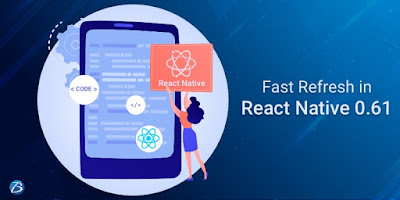What are the Persistent Issues in the React Native Framework?
What Features are Covered in React Native’s 0.61 Version?
How does the ‘Fast Refresh’ Feature in this Update Impact
the Developer Community?
All
such questions about React Native 0.61 version will be
covered in this blog. We will especially elaborate on the Fast Refresh Feature
in this blog. So without much delay, let’s get started.
A Bit about React Native 0.61
React
Native 0.61 is quite a small update comparatively. It is an attempt to resolve
several persistent issues present in the older versions. The broken
hot-reloading feature was one of the biggest pain points for React Native App Developers and the
Community. This new update majorly focuses on a new reloading experience called
Fast Refresh. With this update, the developer community can heave a sigh of
relief.
But
before looking into features in this new version, let’s have a quick look at
the persistent issues in React Native. Like any other technology, this
technology had several shortcomings and no matter how small, but these
shortcomings did affect the overall mobile app development.
Shortcomings in React Native Framework!
Hot-reloading Issue: Being one of
the most popular features of React Native, the hot-reload feature got much
attention from the developer community. But sadly, it didn’t go that well and
especially failed to work appropriately with Stateless Functional Components
(SFC). In the React Native 0.61 version, this issue has been fixed, and now,
reloading any React Native code reliably is possible without reloading the
complete application.
Time-consuming Updating Process: Updating
React Native from an older version to a new one is tedious and needs a lot of
time. This process especially becomes highly time-consuming in case the React
Native Developers haven’t installed a few updates and then want to update it
once for all.
Sudden App Crashes at Times: Several
times, React Native apps can crash suddenly and there is not much information
available to know the reason for such app crashes.
Finding Main Reason of Exception: Finding the
main reason for the exception is quite challenging in the React Native framework. Stack trace
in the Chrome debugger console makes the debugging process much time-consuming.
In this case, component DidCatch also doesn’t seem much helpful.
Issues with Ram Bundle: The ram
bundle of React Native isn’t supported by any OTA platform like CodePush. This issue
is caused since React Native community is not connected widely.
So,
to overcome such challenges and solve the existing bugs, React Native 0.61 was
introduced. New features in this version will help the developer community to
leverage an improved development process and also result in a better
end-product.
Notable Features of React Native 0.61 and its Impact on
the Developer Community
Better CocoaPods support: A few
updates in the 0.60 version of React Native were by default made to integrate CocoaPods. But this
leads to several issues in the use_frameworks! But thankfully, this issue is being
worked upon and fixed in 0.61. After this update, it has become much simpler to
integrate React Native into the iOS projects that are developed with dynamic
frameworks.
React 16.9 Upgrade: In this version, there have been
improvements to act. Also, the old names for the UNSAFE_ lifecycle methods have
been deprecated.
The ‘useWindowDimensions Hook’ Feature: Hook is
another fascinating feature introduced in this version that offers and
subscribes to dimension updates. This feature can be used instead of the
Dimensions API in several cases.
Fast Refresh: The “hot reloading” and “live reloading”
features have been unified into a single feature called “Fast Refresh” for
addressing the hot-reloading issue. This update is quite helpful to the
developer community and every React Native App Development Company. So, let us
have a quick look at what’s so impressive about this feature.
Significance of the Fast Refresh Feature
The hot-reload issue needed enhancements for a long time and in this update, it has been addressed. So, what are these enhancements, and how is these will impact the developers as well as React Native App Development services leveraging this framework? Please read along.
- The feature doesn’t exercise invasive code transformations. Thus, the code can be considered more reliable and trustworthy even if kept ON in the settings by default.
- This feature provides complete support to new-age React along with function components and Hooks completely.
- This feature helps to skilfully recover from typos and similar mistakes. Besides, whenever required, the Fast Refresh feature can be switched to full reload.
Final Views:
We
have seen several features of React Native 0.61 version along with its Fast
Refresh feature. About this feature, the developer community finds it much
flexible to use. It works well for both functional components and class
components. Though it is almost similar to the hot-reloading feature, this
time, it is much more efficient and excellent in performance.
The core technologies we offer:

















